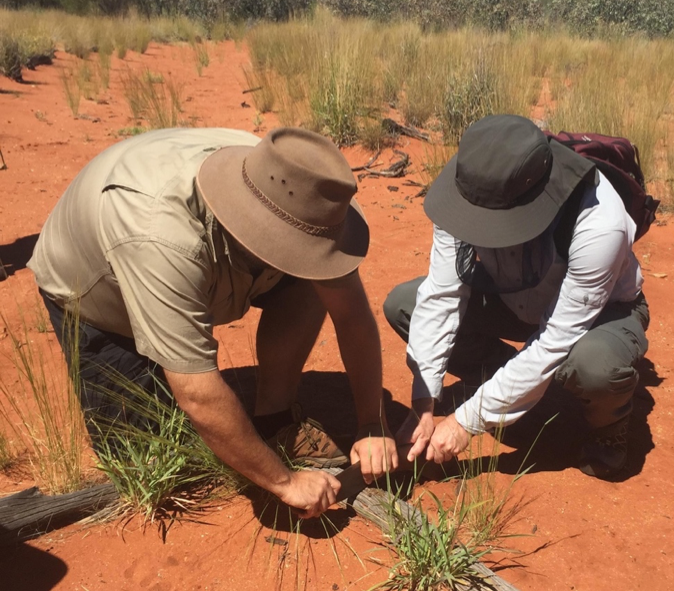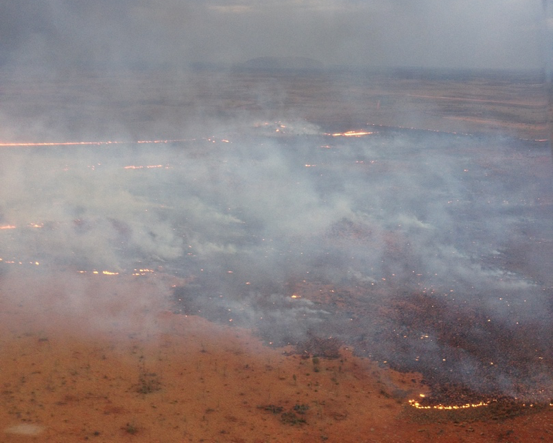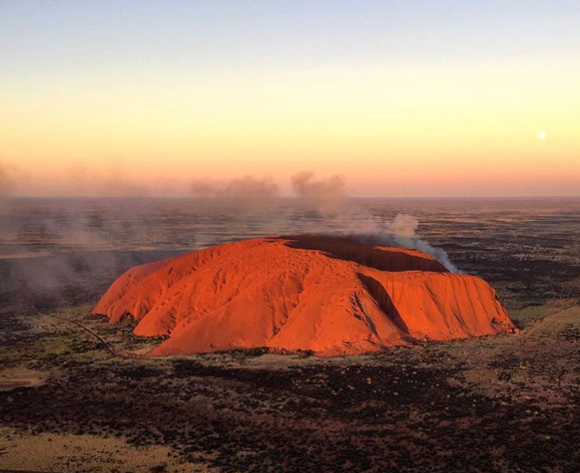Fire Waru outback Australia – G’day. Today I’d like to share with you some information about the wildfires and the planned burns that happen throughout winter in central Australia. That way when you do eventually head our way, you know a little bit more about what to expect.

Burning off happening at Uluru Kata Tjuta National Park during the winter months Photo Credit: IG: @mon_a_tron
Fire – Waru – in Pitjantjatjara, one of the languages spoken by Anangu people.
The Anangu People have used burning off for many years. As they lived with the land and used its supplies, they did their very best to care for it. For Anangu the earth is like their mother. It will look after them and provide for them as long as they show respect and look after it too.
Generally, when an area had been inhabited for some time and it was time to move on the seniors of the group had the job of going along with their tjangi (firesticks) burning the small scrubland in order to help regenerate the land. When they returned to the area after rain the land is full of food, not only for themselves but for all the animals that rely on the area as well. If you join our Uluru touring on your visit to Uluru, you can hear the story of Lungkata the blue tongue lizard. His story starts with him travelling from the west and on his journey towards Uluru he burns the land off.

Lungkata the Blue tongue lizard is one of the Tjukurpa creation beings, whose story can be found at the base of Uluru.
Anangu are known to use fires for many different reasons not just to regenerate the land. For starters the men and women use fire, ash and coals to cook all sorts of kuka, hunted meats like Malu (kangaroo), Kanyala (euro) Kalaya (emu) Ngintaka (perentie) Tinka (goanna), Kipara (Bush Turkeys) and mai, gathered foods like maku (witchetty grubs) and nyuma (seed cakes)
Fire was also an excellent tool to keep warm. It isn’t unusual to drive up the highway in winter and come across a car with Anangu waiting for fuel, all sitting around a small fire.
When Anangu go out hunting and gathering/exploring its quite common for them to light a fire so others are aware of their presence. If their car breaks down not too far from a community, they will light a fire and put old car tyres on it to send up dark smoke signalling that they need assistance.

Traditional ways to start a fire using either the Kali or the Miru (boomerang and spear thrower)
Photo credit: IG @walpageorge
Burning Off
To control the damage any wildfires passing through may cause to the surrounding land, Uluru Kata Tjuta National Park use a fire management strategy with the local Anangu seniors which helps keep the park from becoming overgrown. Patch burning works by limiting the amount of fuel in patches throughout the park. These act as firebreaks if a wildfire does pass through. When the fire reaches one of these patches, there is no more fuel for the fire reducing it in size and protecting the rest of the surrounding areas.

Photo: IG: @jwr87_ Uluru covered by a haze of smoke while the fire burns heading towards the rock.
The mosaic burning pattern the park uses takes around 20 years to complete. Its not uncommon to see small fires burning in the national park throughout our winter months as 5% of the park is burnt every year.
Its the Anangu seniors that are in charge of this patch burning with the assistance of park staff. The reason this process was implemented was due to 3 different fires in recent years.
Back in 1950 was the first of these fires. The Anangu had been driven away from the land back in the 1930’s. Leaving 20 years of back burning to catch up on. Unfortunately, it was wildfires that took care of all the overgrowth burning 30% of the national park.

Yearly burns in the cooler months take place around the base of Uluru. Photo Credit: IG @Jw87_
Regrettably, 26 years later it happened again burning a whopping 76% of the national park, attributing to the local extinction of several threatened animal species.

Photo: IG @jwr87_ when lightning hit the ground and the chopper went out to survey the damage- This was the scale of damage within an hour of the fire starting.
Wildfires
These wildfires are generally start towards the end of winter and into spring
During these times the weather is warm during the day, drying the land up. It is in spring time when the storms start to brew. Lightning storms strike and hit the ground causing the dry land to burst into flames. Its not uncommon for for residents of the local town to sit on the sand dunes during these storms and watch small fires start around them. If luck is on our side a little rain will pass through the area and put the fires out. Other times its not so lucky and turns into a full blown wildfire.
Living in the middle of the desert makes it a challenge to control these fires as water supplies to the town are limited. The resort and local communities are protected by fire breaks that have been cleared by fire or a grader in order to leave the ground free of vegetation.

Photo: IG: @mon_a_tron: Mt Conner obscured by smoke.
Out on Curtin Springs Cattle Station the grader the main method of defence from fires. Just recently they had a controlled burn get out of hand when the wind picked up. The next day it was straight on the grader to clear a path around the fire to contain it. Water can’t be used at free will out there as they are operating their station by relying on bore water to water the cows. They also need to protect as much of the vegetation as they can as the cows can only eat what grows naturally on the property.
Joining SEIT Tours’s touring in Central Australia will give you the opportunity to learn about fires, the patch work burning, and traditional fire starting methods.
Our SEIT Bush Tucker and Reptiles tour and the SEIT Cave Hill tour gives you the opportunity to try the traditional methods and learn about the tools used for this. Not only do you get to learn about the fire starting, but you get the chance to explore the area and discover that it really isn’t as baron as it seems.
